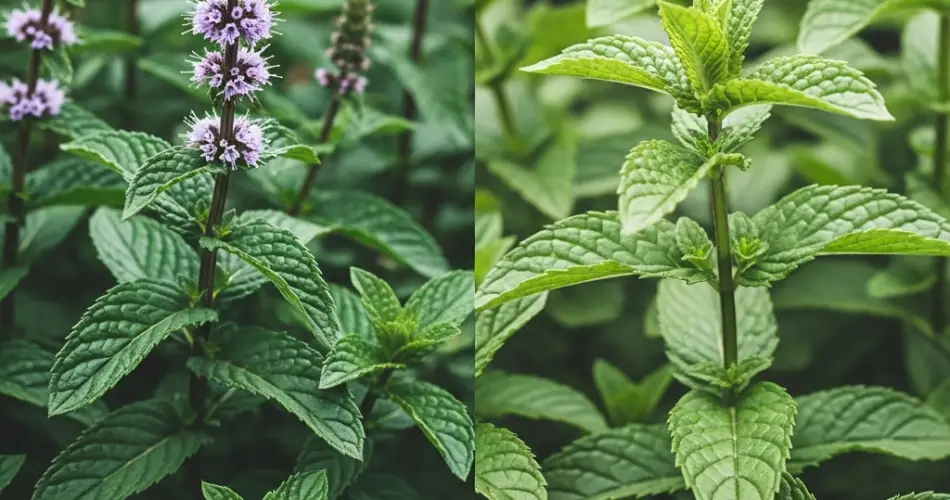Peppermint and spearmint are two of the most popular types of mint used in cooking, tea, and natural remedies. While both share the same family and basic growth habits, each has a distinct flavor profile and growing preference. If you enjoy having a variety of herbs at your fingertips, growing both peppermint and spearmint in your garden or on your balcony is a great idea. However, mints are known for their aggressive spreading habits and tendency to cross-pollinate. Here’s how to grow peppermint and spearmint side-by-side successfully while keeping them healthy, flavorful, and contained.
Understanding the Differences
Before planting, it’s helpful to understand the basic differences between the two:
-
Peppermint (Mentha × piperita) has a stronger, cooler flavor due to its higher menthol content. It is a natural hybrid between spearmint and watermint.
-
Spearmint (Mentha spicata) has a milder, sweeter taste and is often used in savory dishes and drinks like mojitos.
While they may look similar, their flavors and oil contents make them suitable for different culinary uses.
Choosing the Right Growing Location
Both peppermint and spearmint thrive in similar conditions:
-
Light: Full sun to partial shade. In hotter climates, some afternoon shade helps prevent wilting.
-
Soil: Moist, well-draining soil with a slightly acidic to neutral pH (6.0 to 7.0).
-
Water: Regular watering is essential. Mint enjoys consistently moist (but not waterlogged) soil.
Mint is hardy and can tolerate a range of growing environments, but for the best results, ensure they have room to grow without competing too closely with other plants.
The Importance of Containment
One of the biggest challenges with growing mint is its invasive nature. It spreads rapidly via underground runners and can easily take over garden beds if not contained.
Tips for containment:
-
Grow in Pots: The best way to grow peppermint and spearmint side-by-side is in separate containers. Use 8- to 12-inch pots with drainage holes and place them near each other in your garden or balcony.
-
Use Root Barriers: If planting in the ground, sink bottomless containers or root barriers at least 12–18 inches deep to prevent roots from spreading.
-
Keep Them Apart: To avoid flavor mixing and cross-pollination, space the plants at least a few feet apart or keep their pots separated. This is especially important if you plan to harvest leaves for culinary use.
Planting Instructions
-
Start with Healthy Plants or Cuttings: Mint is easy to propagate. You can grow new plants from nursery seedlings or cuttings placed in water until they root.
-
Use Quality Potting Mix: If growing in pots, choose a well-draining potting mix rich in organic matter. Mix in a little compost to promote strong growth.
-
Plant at the Same Depth: Place each mint plant at the same depth it was growing previously. Firm the soil gently around the roots and water well.
Care and Maintenance
Mint requires relatively low maintenance but responds well to regular care.
-
Watering: Keep soil evenly moist, especially during hot or dry weather. Avoid letting the soil dry out completely.
-
Feeding: Mint isn’t a heavy feeder. Fertilize lightly once a month with a balanced organic fertilizer or compost tea.
-
Pruning: Regularly pinch off the tops to encourage bushier growth and prevent flowering. Once mint flowers, the leaves can lose their best flavor.
-
Harvesting: You can start harvesting once the plant reaches about 6 inches tall. Always leave a few inches of stem so the plant can regrow.
Preventing Cross-Pollination
If you plan to collect seeds from your mint plants, avoid growing different varieties close together. Peppermint and spearmint can cross-pollinate, resulting in unpredictable offspring.
To prevent this:
-
Remove flowers as soon as they appear.
-
Keep different mint types separated, especially during flowering season.
-
Propagate new plants from cuttings rather than seeds to maintain pure traits.
Pests and Problems
Mint is generally resistant to most pests but can occasionally face issues such as:
-
Aphids: Small insects that cluster on stems and leaves. Spray with water or insecticidal soap.
-
Spider Mites: Tiny pests that leave webbing on leaves. Increase humidity or rinse the plant.
-
Fungal Diseases: Overwatering and poor airflow can lead to mildew or root rot. Ensure good drainage and avoid watering the leaves.
Winter Care
Mint is a hardy perennial in most zones. If you live in an area with cold winters:
-
In Containers: Move potted mint indoors or to a sheltered area before the first frost.
-
In Ground: Cut back the stems to ground level in late fall. Mulch heavily to protect the roots.
In spring, your mint will regrow with renewed vigor.
Final Thoughts
Growing peppermint and spearmint side-by-side can be a rewarding experience if done correctly. The key is containment, proper spacing, and regular maintenance. By following these simple steps, you can enjoy a continuous supply of fresh mint throughout the growing season—perfect for teas, recipes, and refreshing drinks. Whether in a garden bed or a set of containers, mint is a versatile and easy herb to grow for any home gardener.



